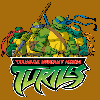
Teenage Mutant Ninja Turtles (2003)
CBUB Wins: 17
CBUB Losses: 9
CBUB Ties: 0
Win Percentage: 65.38%
Added by: Dragoon3k5
Read more about Teenage Mutant Ninja Turtles (2003) at: Wikipedia
Official Site: Mirage Studios
The Teenage Mutant Ninja Turtles (or simply Ninja Turtles) are a fictional team of four anthropomorphic turtle, who were trained by their anthropomorphic rat sensei in the art of ninjutsu and named after four Renaissance artists. From their home in the storm sewers of New York City, they battle petty criminals, evil megalomania, and alien invader, all while remaining isolated from society at large. The characters initially appeared in comic book before being licensed for toys, cartoons, video games, films, and other merchandise. During the peak of its popularity in the late 1980s through early 1990s, the franchise gained considerable worldwide success and fame.
Teenage Mutant Ninja Turtles originated in an American comic book published by Mirage Studios in 1984 in Dover, New Hampshire. The concept arose from a humorous drawing sketched out by Kevin Eastman during a casual evening of brainstorming with his friend Peter Laird. Using money from a tax refund together with a loan from Eastman's uncle, the young artists self-published a single issue comic intended to parody four of the most popular comics of the early 1980s: Marvel Comics' Daredevil and New Mutants, Dave Sim's Cerebus, and Frank Miller's Ronin.
Much of the Turtles' mainstream success began when a licensing agent, Mark Freedman, sought out Eastman and Laird to propose wider merchandising opportunities for the offbeat property. In 1986, Dark Horse Miniatures produced a set of 15 mm lead figurines. In January 1988, they visited the offices of Playmates Toys Inc, a small California toy company who wished to expand into the action figure market. Development initiated with a creative team of companies and individuals: Jerry Sachs, ad man of Sachs-Finley Agency, brought together the animators at Murakami-Wolf-Swenson, headed by award-winning animator Fred Wolf. Wolf and his team combined concepts and ideas with Playmates marketing crew, headed by Karl Aaronian and then VP of Sales, Richard Sallis and VP of Playmates, Bill Carlson. Aaronian brought on several designers and concepteer and writer John Schulte and worked out the simple backstory that would live on toy packaging for the entire run of the product and show. Sachs called the high-concept pitch "Green Against Brick". The sense of humor was honed with the collaboration of MWS's writers. Playmates and their team essentially served as associate producers and contributing writers to the miniseries that was first launched to sell-in the toy action figures. Phrases like "Heroes in a Half Shell" and many of the comical catch phrases and battle slogans ("Turtle Power!") came from the writing and conceptualization of this creative team. As the series developed, veteran writer Jack Mendelsohn came on board as both a story editor and scriptwriter. David Wise, Michael Charles Hill, and Michael Reaves wrote most of the scripts, taking input via Mendelsohn and collaborating writer Schulte and marketing maven Aaronian.
The miniseries was repeated three times before it found an audience. Once the product started selling, the show got syndicated and picked up and backed by Group W, which funded the next round of animation. The show then went network, on CBS. Accompanied by the popular Teenage Mutant Ninja Turtles 1987 TV series, and the subsequent action figure line, the TMNT were soon catapulted into pop culture history. At the height of the frenzy, in the late 1980s and early 1990s, the Turtles' likenesses could be found on a wide range of children's merchandise, from Pez dispenser to skateboard, breakfast cereal, video games, school supplies, linens, towels, cameras, and even toy shaving kits.
Images with a green border may be set as the character's main profile image (For images 200x200 or 300x300 pixels square).
CBUB Match Record:
| Result | Opponent | My Score | Their Score | |
|---|---|---|---|---|
| Win | Blade | 60 | to | 31 |
| Win | Steve Irwin the Crocodile Hunter | 54 | to | 43 |
| Loss | Nightcrawler | 56 | to | 60 |
| Win | Tarzan (Disney) | 69 | to | 10 |
| Loss | Nimrod | 50 | to | 64 |
| Win | Biker Mice From Mars | 94 | to | 15 |
| Loss | Deadpool | 42 | to | 69 |
| Win | Mighty Morphin Power Rangers | 73 | to | 39 |
| Win | Battletoads | 71 | to | 25 |
| Win | The Manhattan Clan | 48 | to | 39 |
| Win | Samurai Pizza Cats | 80 | to | 24 |
| Win | Mario | 52 | to | 33 |
| Win | ThunderCats | 64 | to | 58 |
| Win | Samurai Jack | 63 | to | 44 |
| Loss | Teen Titans (2003 TV series) | 91 | to | 94 |
| Win | The Manhattan Clan | 73 | to | 48 |
| Win | Stan, Kyle, Cartman & Kenny | 72 | to | 28 |
| Loss | The Killer Tomatoes | 61 | to | 71 |
| Loss | Teenage Mutant Ninja Turtles (Mirage) | 6 | to | 20 |
| Win | Princess Azula | 27 | to | 7 |
| Win | The Seven Samurai | 22 | to | 14 |
| Loss | ThunderCats | 11 | to | 13 |
| Loss | The Guardian (Samurai Jack) | 14 | to | 19 |
| Loss | The Batman Family | 8 | to | 11 |
| Win | The J-Team | 5 | to | 3 |
No Fantasy Draft Records Available



